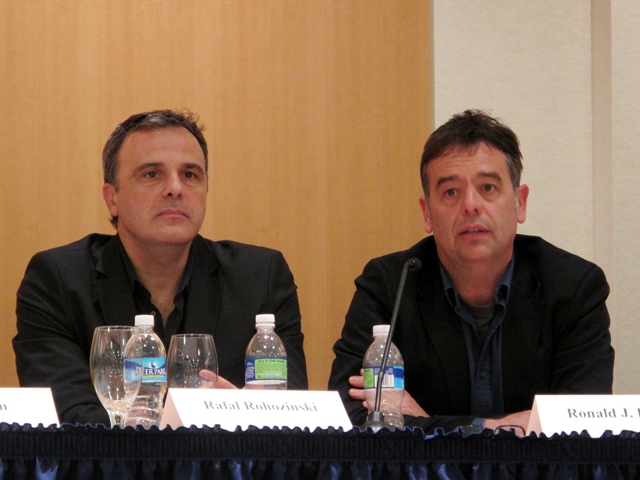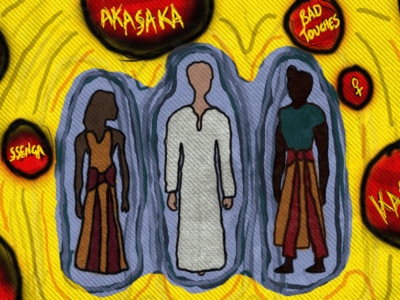Over the last year we have seen a significant number of government initiatives and state-sponsored actions concerning the Russian Internet. They included an increase in activity of the authorities in the virtual space [ENG], endless discussions of new Internet regulation legislation, suggestions of new projects (e.g., development of the e-gov services [RUS], a national search engine [ENG], national OS, state e-mail accounts and a project for searching new talents [ENG]), active regulation policy aimed at reducing the digital divide [ENG], the emergence of the new Cyrillic domain [ENG], etc. These trends were summarized [ENG] by Alexey Sidorenko in his talk at the 2010 GV Summit in Santiago [ENG].
Following these developments, there are two important questions: 1. Where do these trends lead? and 2. What are the major motivations and goals of the state actor behind it? I would like to suggest that all these initiatives have two interrelated goals that lead to a particular desired future model for the Russian cyberspace:
- to increase the density of online interaction inside Russia among Russian citizens and primarily between citizens and the government (government as a hub connected to every citizen);
- to decrease online interaction with the rest of the world, and consequently, to isolate the Russian cyberspace from the global network.
Increasing internal density and decreasing external communication are the two elements of the strategy that aim at developing something more than just a national cyberzone. The current Russian ideological framework was named by Russian ideologists as “sovereign democracy” [ENG]. It looks as if the virtual equivalent of “sovereign democracy” is a model of “sovereign Internet” that is currently developing in Russia. Its goal is much more far-reaching than controlling the flow of information. Actually, the model recognizes the lack of ability to manage this type of control. Instead of direct and total control, this model aims at recreating the state through cyberspace and encouraging citizens to stay within this framework.
Creation of national cyberzone: increasing internal interaction
Despite the collapse of the USSR, Russia is still the biggest country in the world. The country’s size creates a geopolitical challenge for governance and management. For instance, how Moscow can control what’s going on in Sakhalin? Moreover, the size creates a challenge for maintaining a state-related identity of citizens. Geographical distance and the crises that followed the collapse of the USSR created a significant threat of Russia's further fragmentation. Many political analysts draw a future when regions, especially those with strong national and/or religious common denominators, will fight for independence and the Russian Federation will fall apart. Moreover, Internet-based communities can also contribute to the state fragmentation process. At the same time, cyberspace can also play a role as a place for recreation of the state identity and preservation of state unity.
Russia is not the only country struggling with its own geography. For instance, Chile, which also has a geographical challenge, approaches the Internet as a space that can help with governance and strengthen the state identity (this issue, too, was discussed [RUS] at the 2010 GV Summit in Santiago). In the Russian case, having a network that connects all the citizens can be an important element in the struggle against fragmentation. A famous song [RUS] of the Russian rock band Nautilus Pompilius from the mid-1980s said: “Forged together by one goal, connected by one chain.” Television used to play this role of an agent of community, but its impact is gradually decreasing, especially when it comes to the younger generation. The Internet is the information infrastructure that can play a role of a chain that connects people and unites the country.
The role of the Internet as a tool for re-creating the state and addressing geopolitical challenges has three dimensions:
- Re-creation of space (connectivity): Development of infrastructure that provides Internet access to every citizen. Over the last year we have seen a lot of Russian government efforts [ENG] to reduce the digital divide, including regulation of prices, making Internet faster and more widely available;
- Re-creation of governance: Development of electronic government [RUS] and increasing online activity of politicians [RUS] aims at making the government the biggest hub in the country that connects to every citizen. E-gov is not just a service that helps every citizen have access to the government – it’s also a system that helps the government have access to every citizen. Various e-gov projects create unmediated linkage between citizens and the state. The government email system project (in which email accounts would work as unique identifiers, like Social Security numbers (SSN) in the United States) might turn citizens into nodes in the state social network with the government as its nerve center. The increase in activity of top-ranking politicians in cyberspace creates a feeling of unmediated connection between them and the people; it also makes stronger the connection between people in the regions and the leadership in Moscow.
- Re-creation of identity: Benedict Anderson [ENG], a renowned sociologist and the author of the concept of the imagined communities [ENG], described an imagined community as a group of people who, among other things, consume the same information. He suggested that the development of national state was caused by the emergence of newspapers that created “reading together” communities. The Internet is not only a “reading together” space, but also an “interacting together” space. Increasing the government's online activities, including state-citizen interactions, projects that engage citizens (primarily youth) in topics related to the state agenda and framing cyberspace as a national space contribute to blending Russian citizens into one imagined community. Plus, with the help of various emigrant communities, the Russian imagined community is being distributed far beyond the country's geographical borders. It serves the Russian idea of developing a global “Russkiy Mir” (the Russian world) as a global network of Russians.
Creation of national cyberzone: Decreasing external interaction
Significant reduction of the digital divide and development of state-wide information infrastructure is not only part of a solution, but also part of a new problem. On the one hand, Internet offers new opportunities for the country’s unification. On the other hand, it creates access to the global network beyond the state’s borders. In other words, an attempt to find a solution to one threat creates another threat.
Russian “Information Security Doctrine” [RUS], published in 2000, stresses that the information space is used by other countries and hostile forces for the destabilization of Russia. Consequently, controlling the information space is a security issue (this idea was also emphasized in the recent update [ENG] of the Russian Military Doctrine).
In a recent book – “Access Controlled: The Shaping of Power, Rights, and Rule in Cyberspace” [ENG] – Rafal Rohozinski and Ronald Deibert suggest that the next generations of Internet control emerge in RuNet. They write:
In RUNET, control strategies tend to be more subtle and sophisticated and designed to shape and affect how information is received by users, rather than denying access outright.
The authors define three generations of cyberspace control. The first generation is focused on information denial and blocking particular content (e.g., the Chinese model), which is almost not used in Russia. The second generation means creation of “legal and normative environment and technical capabilities that enable actors to deny access to information resources as and when needed, while reducing the possibility of blowback or discovery”. The third generation is the most complex phenomenon. It means shift from reactive to proactive policy and is defined as:
(…) sophisticated, multidimensional approach to enhancing state control over national cyberspace and building capabilities for competing in informational space with potential adversaries and competitors. The key characteristic of third-generation controls is that the focus is less on denying access than successfully competing with potential threats through effective counterinformation campaigns that overwhelm, discredit, or demoralize opponents.
I would like to claim that the development of the national cyberzone should be approached as a type of Internet control and further development of the third generation. The idea to create a national search engine, the launch of Cyrillic domains, e-government projects, etc., shape the information environment that encourages Russian users to stay in the national cyberspace, and consequently create a natural isolation, despite the global nature of the Internet.
The fact that RuNet had been a relatively closed online environment is not new. Rohozinski and Deibert write about the “Russianness” of the Runet:
Unlike much of the Internet, which remains dominated by English and dependent on popular applications and services that are provided by U.S.-based companies (such as Google, Yahoo, and Hotmail), RUNET is self-contained linguistic and cultural environment with well developed and highly popular search engines, Web portals, social networks sites, and free e-mail services.
The increasing activity of the government makes Internet environment not only “more Russian” but also more state-affiliated. First, the new initiatives, e.g. the Cyrillic domain, not only contribute to further the “Russianness” of Runet, but also to implement a higher level of state influence. Secondly, only platforms and software that are supported by the government are used in the educational system. Consequently, they become part of the socialization process for the new generations of “digital natives.”
These trends can not only lead to the increase of online state presence. According to Michael Gurevitch, deputy director of a major Russian Internet company RBC, the development of the state-affiliated national cyberzone can go far beyond (from an interview to GV):
One of the optional scenarios for RuNet development is applying the TV model (when you have a limited number of free TV channels) to the Internet. Once the infrastructure is developed, the government can suggest a free Internet package with limited number of available resources. It will include e-government services, a state-sponsored search engine, a limited number of news websites and a few entertainment portals. I believe that the majority of Russians will take advantage of this free option and will find it satisfying. They won’t want to expand the range of available sites if they have such a free option.
The launch of the national cyberzone with increased state presence as part of socialization, as well as the development of Internet system that encourages national isolation can be labeled as the “fourth generation” of Internet control. In this case, we may expect the emergence of new government projects that contribute to the development of a closed online information environment that enables and supports segregation and remoteness of the Russian online community from the global network. Another path of the nationalization of Runet is increasing investments of the government in popular Russian Internet companies, which makes the state’s involvement subtler.
The isolation can be supported also on an infrastructural level through violation of net neutrality principles. For instance, Rohozinski suggests that access to content beyond the borders of national Internet can be slower or more expensive (one can define it as low-cost connectivity within the national domain zone).
Conclusion: The 4th generation of control
In a book “Power and Powerlessness,” John Gaventa defined three dimensions of power. The first dimension of power is when actor “A” uses his power to influence and defeat “B”. The second dimension of power is the construction of barriers against participation of “B” by controlling the agenda. The third dimension of power is influencing or shaping the consciousness of “B” about inequalities and maintenance of non-participation through socialization and information control. The 4th generation of Internet control, as it was described here, is the development of an Internet environment in a way that facilitates powerlessness and passivity, when Internet users are unaware of the control itself.
The government's increasing cyberactivity aims at re-creating the state through online space. At the same time, it means a new model for increasing state control over the Internet. The process of making RuNet more isolated and at the same time increasing the state presence is slow and natural, unlike other control models. In this case control is not denying, filtering or even competing with other content, but developing an environment that diminishes citizens’ motivation to look beyond the range of the national and state-affiliated resources.
On the one hand, the national cyberzone is a system that motivates isolation. On the other hand, it intensifies internal communication and supports the role of the government as a nerve center, a hub of the system. Being a hub in such a context, together with maintaining common denominator, means protection of the state’s sovereignty. However, the most unique characteristics of “sovereign Internet” is that its control model is based on free will of the Internet users. Consequently, it can’t be bypassed through technological means. In this case, the change is not about the technology but primarily about the people and the social environment.
Rohozinski and Deibert suggest that RuNet is a model of development for other national segments of the World Wide Web. Consequently, the question that one should ask is whether we are moving towards the reality of global space fragmentation and the emergence of many “sovereign Internets.” To answer this question, further research should focus on comparative outlink analysis of national cyberzones and analysis of international online traffic, comparing local Internet traffic within states.









8 comments
Dear Gregory,
An very interesting and thought-provoking post. There is no doubt that the Russian government is busy, as you say, “recreating the state through online space”. That is, I suppose, the whole point and rationale of e-government. However, it is not just about control. It should make life easier for most people and give them more time to spend on their own pursuits rather than queuing for endless hours at government offices. So, in that sense, it is a liberating factor.
E-government also seems to be having some happy unintended consequences. For example, Aleksey Navalnyy takes advantage of the opportunities provided by e-government rules to harrass lazy, incompetent, dishonest and corrupt officials. His example shows that it can even be used for mass action.
This is just one example of how government officials are not able to operate on their own terms in cyberspace. Another might be the experience of various blogger-officials. The ones who fail to adapt to the internet culture inevitably end up looking stupid and isolated. Success requires adaptation, which means at least the appearance of responsiveness and tolerance of criticism.
So, notwithstanding the validity of the points you make about the Kremlin trying to exert control over the internet, I believe there are signs that this process will not all be one-way traffic.